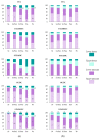Soybean Oil Replacement by Palm Fatty Acid Distillate in Broiler Chicken Diets: Fat Digestibility and Lipid-Class Content along the Intestinal Tract
- PMID: 33917521
- PMCID: PMC8067497
- DOI: 10.3390/ani11041035
Soybean Oil Replacement by Palm Fatty Acid Distillate in Broiler Chicken Diets: Fat Digestibility and Lipid-Class Content along the Intestinal Tract
Abstract
Palm fatty acid distillate (PFAD) is a by-product of palm oil (P) refining. Its use in chicken diets is a way to reduce the cost of feed and the environmental impact. Its low unsaturated:saturated fatty acid ratio (UFA:SFA) and its high free fatty acid (FFA) level could be partially counteracted by its blending with soybean oil (S). The objective was to assess the effect of replacing S with different levels of PFAD on lipid-class content and fatty acid (FA) digestibility along the intestinal tract and in the excreta of 11 and 35-day-old broiler chickens. Five experimental diets were prepared by supplementing a basal diet with S (S6), PFAD (PA6), two blends of them (S4-PA2 and S2-PA4), or P (P6) at 6%. Replacing S with PFAD did not affect performance parameters (p > 0.05) but negatively affected feed AME, FA digestibility, and FFA intestinal content (p < 0.05), especially in starter chicks. Including PFAD delayed total FA (TFA) absorption (p < 0.05) at 11 days, but at 35 days it did not affect the TFA absorption rate. The use of PFAD blended with S, when FFA ≤ 30% and UFA:SFA ≥ 2.6, led to adequate energy utilization in broiler grower-finisher diets.
Keywords: alternative energy source; broiler chickens; fat by-product; fat digestibility; fatty acid distillate; free fatty acid; intestinal tract; lipid classes; poultry.
Conflict of interest statement
The authors declare no conflict of interest. The funders had no role in the design of the study; in the collection, analyses, or interpretation of data; in the writing of the manuscript, or in the decision to publish the results.
Figures


References
-
- Statista Vegetables Oils Global Consumption. [(accessed on 29 January 2021)]; Available online: https://www.statista.com/statistics/263937/vegetable-oils-global-consump...
-
- FEDIOL The European Vegetable Oil and Protein Meal Industry Association—Refining of Edible Oils. [(accessed on 20 March 2021)]; Available online: www.fediol.eu/web/refining/1011306087/list1187970096/f1.htm.
-
- Gibon V., De Greyt W., Kellens M. Palm oil refining. Eur. J. Lipid Sci. Technol. 2007;109:315–335. doi: 10.1002/ejlt.200600307. - DOI
Grants and funding
LinkOut - more resources
Full Text Sources
Other Literature Sources
Research Materials

